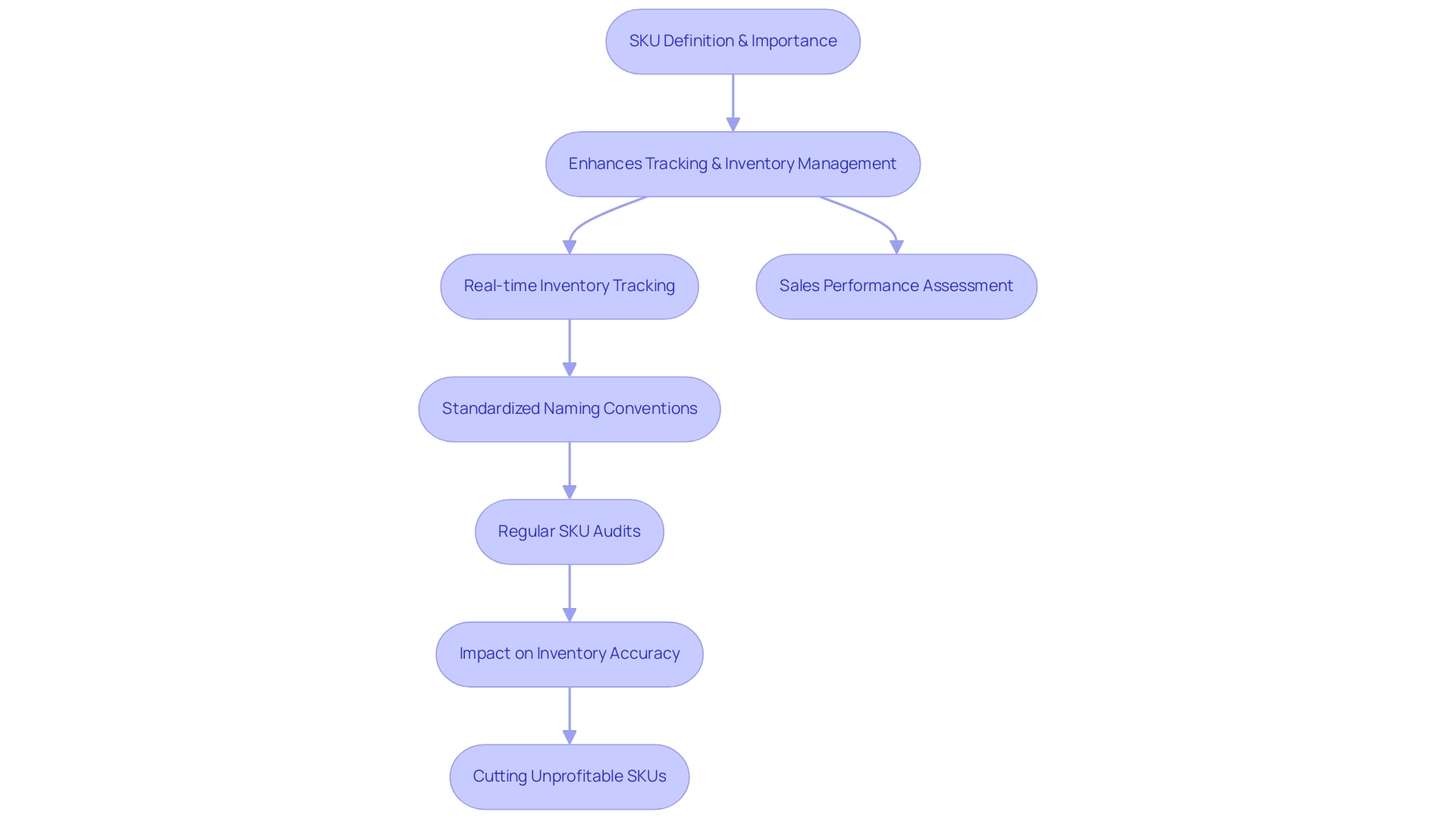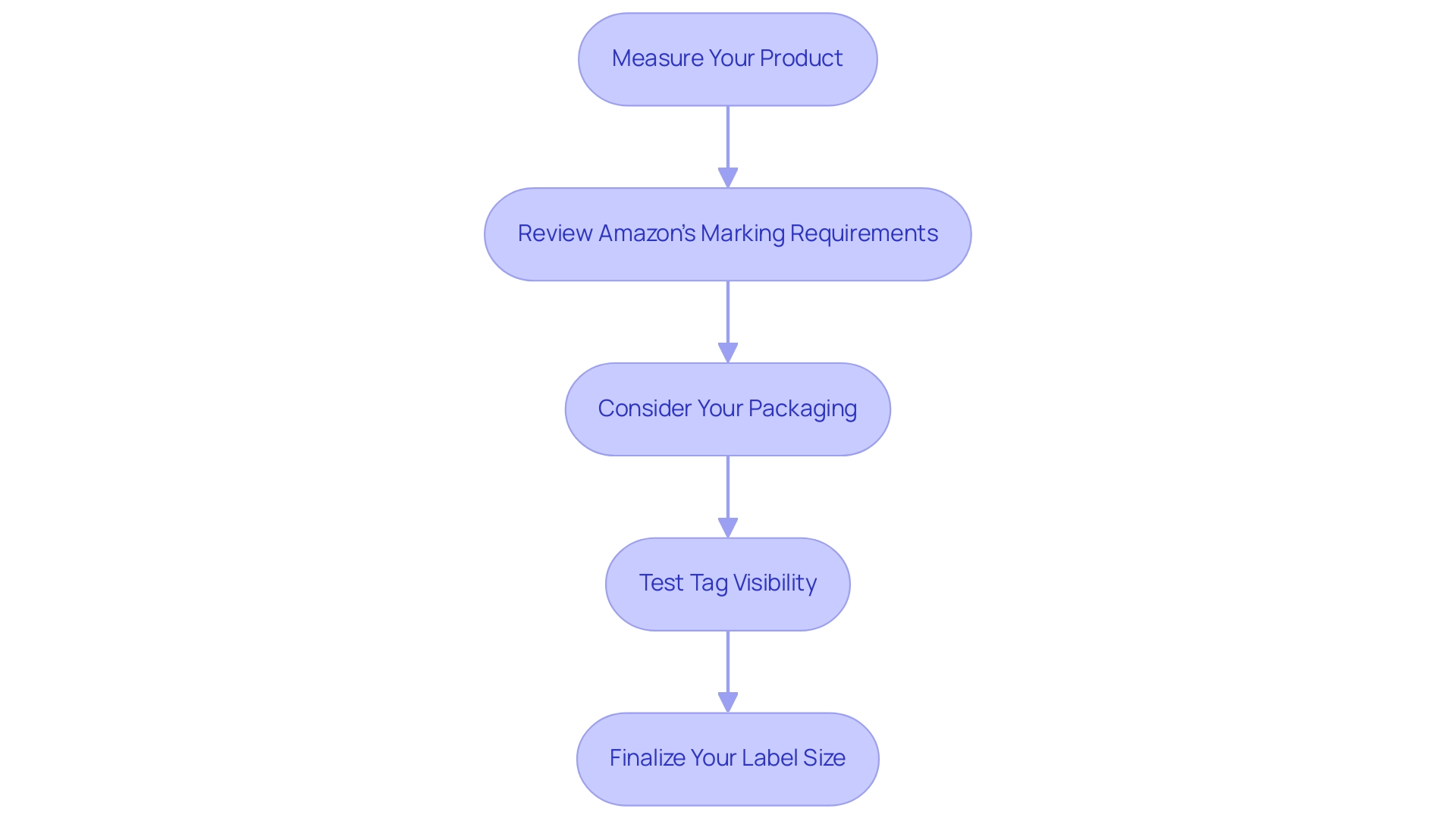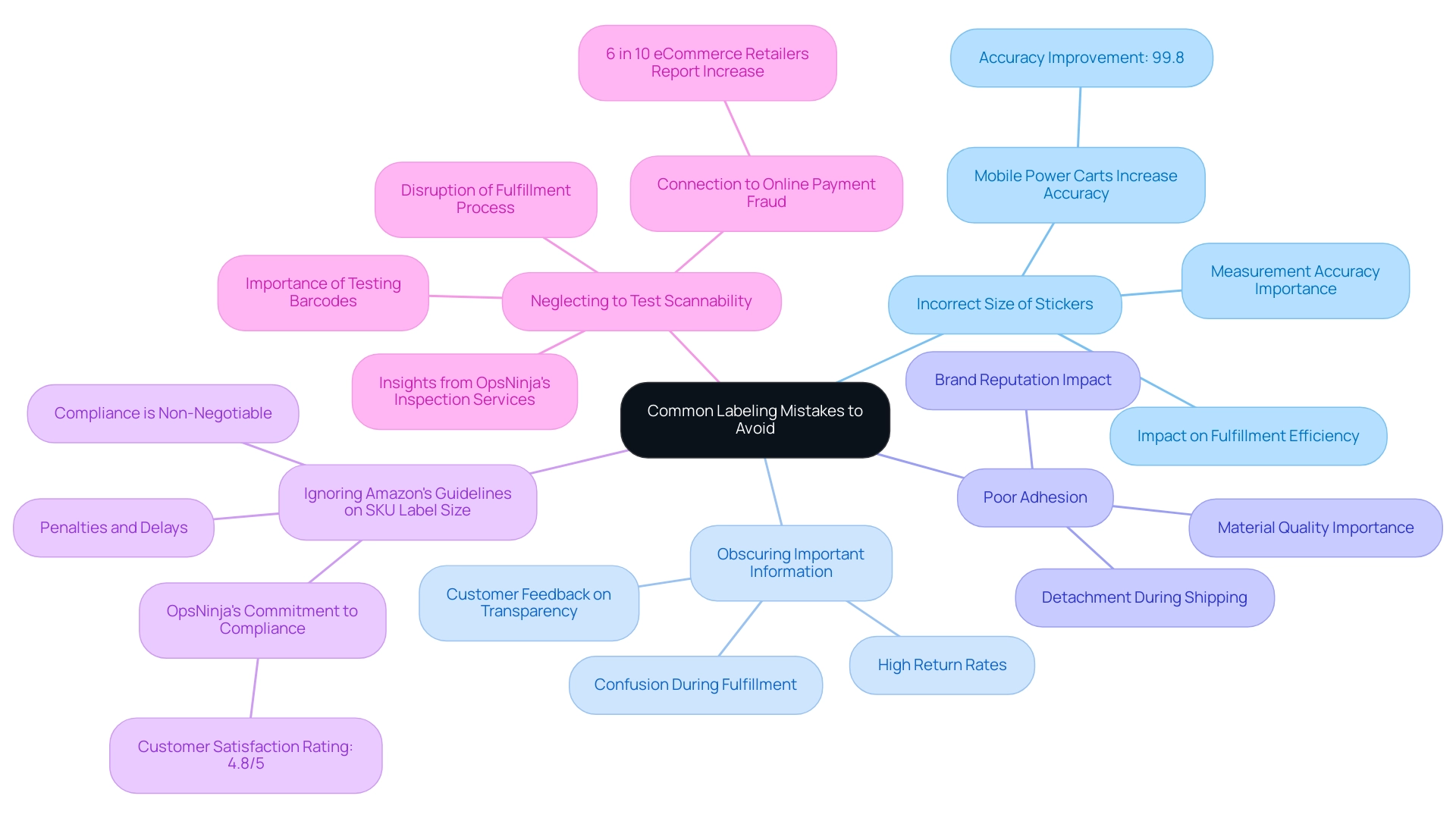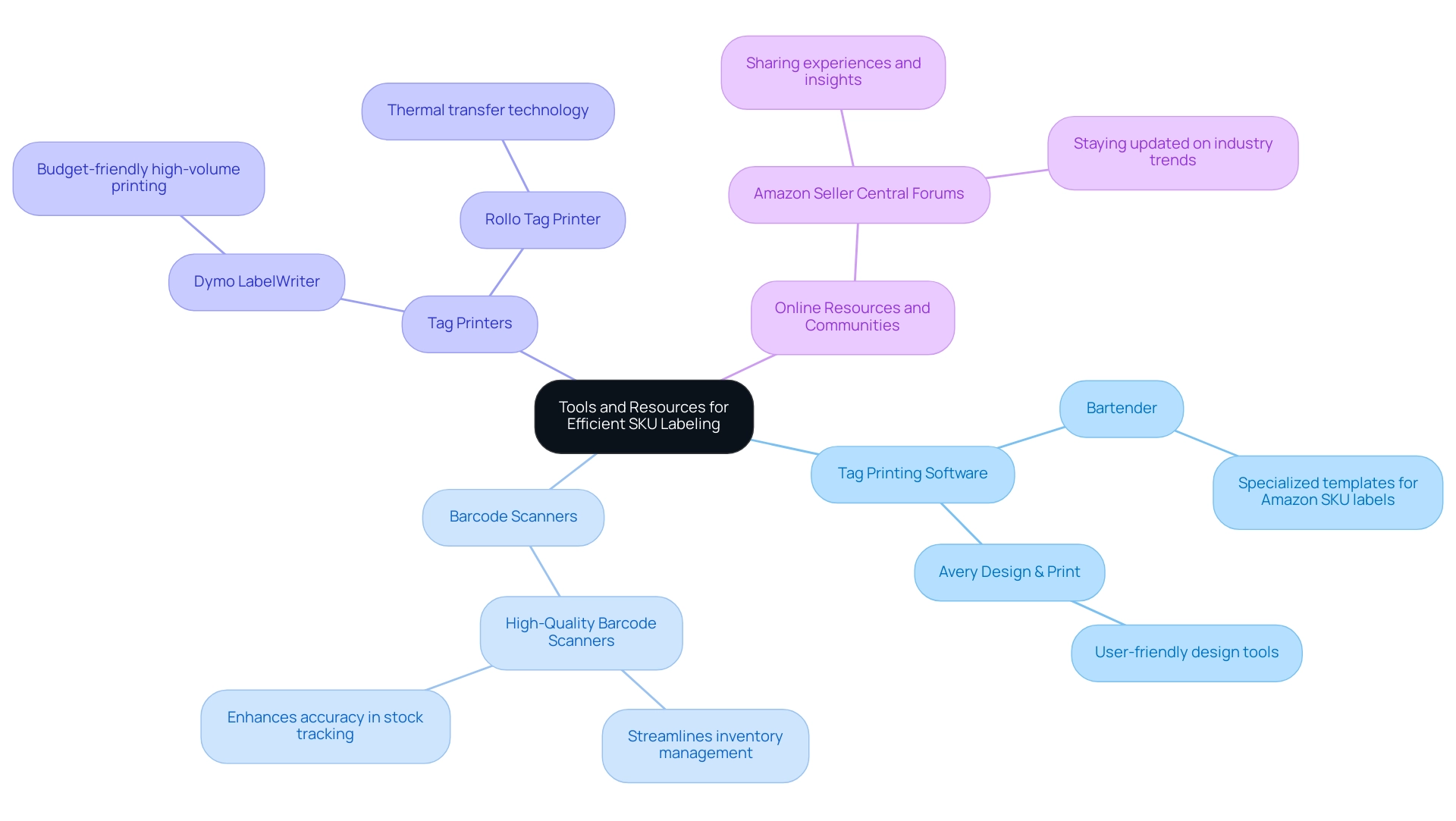How to Choose the Right Amazon SKU Label Size: A Step-by-Step Guide
Learn how to select the perfect Amazon SKU label size for optimal visibility and compliance.

Overview:
Choosing the right Amazon SKU label size involves measuring the product dimensions, understanding Amazon's specific marking requirements, and ensuring visibility and adherence without obstructing important information. The article supports this by outlining a step-by-step guide that emphasizes the importance of compliance with Amazon's guidelines to enhance operational efficiency and customer satisfaction, backed by research showing improved inventory accuracy with proper labeling practices.
Key Highlights:
- SKU labels are unique identifiers that enhance tracking and inventory management.
- Utilizing eCommerce analytics with SKU tags helps manage stock levels and fulfill orders accurately.
- Standardized naming conventions in SKU management are essential for consistency.
- Research shows item-level tagging can boost inventory accuracy from 63% to 95%.
- Effective SKU management improves customer satisfaction by ensuring timely and accurate delivery.
- Common labeling mistakes include incorrect sticker sizes, obscuring important information, and poor adhesion.
- Adhering to Amazon's SKU label size requirements is crucial to avoid penalties and ensure compliance.
- Tools like tag printing software and barcode scanners improve the efficiency of SKU labeling.
- Best practices for label placement include choosing visible locations and avoiding wrinkles or bubbles.
- Educating teams on labeling best practices is vital for maintaining quality and consistency.
Introduction
In the competitive landscape of eCommerce, the significance of effective SKU labeling cannot be overstated. These unique identifiers are not merely logistical tools; they are pivotal in enhancing inventory management, order fulfillment, and overall operational efficiency. As businesses strive to meet the demands of platforms like Amazon, understanding the intricacies of SKU labels—from their design and placement to compliance with industry standards—becomes essential.
This article delves into the critical components of SKU labeling, offering insights into best practices, common pitfalls to avoid, and the tools that can streamline the labeling process. By adopting a strategic approach to SKU management, businesses can not only improve their operational workflows but also elevate customer satisfaction and drive profitability.
Understanding SKU Labels: Definition and Importance
SKU (Stock Keeping Unit) tags serve as essential unique identifiers for products, significantly enhancing tracking and inventory management capabilities. Utilizing eCommerce analytics, including real-time inventory tracking and sales performance assessment, alongside these tags enables sellers to effectively manage stock levels, correctly fulfill orders, and perform meaningful sales data analysis, which is vital for tackling quality issues in the supply chain. The importance of SKU labels, particularly the amazon sku label size, cannot be overstated; they are vital for operational efficiency and are essential for compliance with platforms like Amazon, which mandates clear and standardized labeling for their Fulfillment by Amazon (FBA) service.
Establishing standardized naming conventions is crucial to maintain consistency and avoid confusion in SKU management. Additionally, implementing best practices such as regular audits of the SKU system can further enhance operational efficiency. Research from the Auburn University RFID Lab indicates that retailers utilizing item-level tagging can boost inventory accuracy from an average of 63% to an impressive 95%.
Such precision not only reduces the risk of costly errors, including mislabeled items and missing units, but also enhances customer satisfaction by ensuring timely and accurate delivery. Furthermore, incorporating analytics can streamline UPC code verification, ensuring compliance and quality throughout the supply chain. A practical example of the impact of effective SKU management is illustrated in the case study titled 'Cutting Unprofitable SKUs,' where SKU analysis identified low-performing SKUs to eliminate, freeing up resources for higher-value items and improving overall profitability.
Adopting proper practices for amazon sku label size is a strategic move that not only enhances operational efficiency but also directly affects the bottom line and overall business performance.

Step-by-Step Guide to Choosing the Right SKU Label Size
- Measure Your Product: Begin by carefully measuring your product's dimensions, including its length, width, and height. This initial step is crucial as it informs how much space is available for your SKU tag, ensuring it fits appropriately on the packaging.
- Review Amazon's Marking Requirements: Acquaint yourself with Amazon's specific guidelines regarding marking size and placement. The standard amazon sku label size is usually 1 inch by 2.625 inches; however, variations may occur based on the distinct features of your item. Additionally, Amazon suggests a resolution exceeding 300 DPI for printing to ensure clarity and scannability.
- Consider Your Packaging: Evaluate the packaging of your product. It’s essential to choose a size for the tag that adheres well to the packaging without obstructing any critical information or branding elements. A well-placed tag enhances both functionality and aesthetics.
- Test Tag Visibility: Print a sample tag and apply it to your product packaging to assess its visibility and readability. Verify that the barcode is scannable and that all text is legible, as these factors directly influence customer experience and operational efficiency.
- Finalize Your Label Size: After conducting visibility tests and confirming that the label meets all necessary criteria, finalize your label size. Ensure it complies with Amazon's requirements, particularly the amazon sku label size, maximizing your chances for successful integration into their marketplace.
As Jeannell Darden, Founder & CEO of Moisture Love, noted, 'We realized we needed a new customer channel, and we needed some logistical support that was a lot more robust than what we had.' This underscores the significance of strategic categorization in navigating Amazon FBA. Furthermore, consider the case of New Republic, which found that adding Amazon as a sales channel reinforced their brand story and customer trust, proving that proper labeling plays a crucial role in this broader business strategy.

Common Labeling Mistakes to Avoid
-
Incorrect Size of Stickers: Utilizing stickers that are either too small or excessively large can significantly hinder scannability, ultimately impacting fulfillment efficiency. For clothing brands, where sizing precision is crucial, it's vital to measure your items accurately before determining a size. OpsNinja's inspections, which include detailed methodologies for assessing size accuracy, have shown that using mobile power carts can increase marking accuracy by as much as 99.8%, which directly correlates to improved fulfillment efficiency and reduced return rates due to sizing errors.
-
Obscuring Important Information: Ensure that SKU tags do not obscure vital product details or barcodes. Labels that cover essential details can create confusion during the fulfillment process, leading to increased errors and potential delays. This oversight can be particularly detrimental for apparel brands dealing with high return rates, as emphasized by customer feedback on the need for transparency in labeling.
-
Poor Adhesion: The selection of material quality is critical. Low-quality adhesive tags or improper application can result in them detaching during shipping. To avoid this, always opt for high-quality adhesive labels that can withstand the rigors of transit. As emphasized by customer testimonials, maintaining integrity during shipping is essential for brand reputation.
-
Ignoring Amazon's Guidelines on the SKU Label Size: Adhering to Amazon's labeling requirements is non-negotiable. Non-compliance can lead to penalties or delays in product listings, which can severely affect your sales and reputation. Regularly reviewing Amazon's policies ensures that your Amazon SKU label size meets their standards, and OpsNinja encourages this practice to help mitigate quality control challenges. OpsNinja's commitment to compliance contributes to their excellent customer satisfaction rating of 4.8 out of 5.
-
Neglecting to Test Scannability: Testing the barcode on your SKU tag is crucial to ensure it scans correctly. A non-scannable label can disrupt the entire fulfillment process, leading to inefficiencies and customer dissatisfaction. OpsNinja's detailed inspection services offer insights into potential tagging issues before they escalate into costly returns. Furthermore, with almost 6 in 10 eCommerce retailers indicating a rise in online payment fraud, establishing strong identification practices is essential to avoid complications and improve pricing strategies, as emphasized in case studies investigating the connection between shipping errors and pricing efficiencies.

Tools and Resources for Efficient SKU Labeling
-
Tag Printing Software: To create and print your SKU tags efficiently, consider utilizing specialized software such as Bartender or Avery Design & Print. These platforms offer a variety of templates designed to meet Amazon's rigorous labeling standards, including the amazon sku label size, ensuring adherence and professionalism in your presentation. Considering the highly competitive landscape of the printing software market, where established players are constantly innovating, utilizing these tools can provide you with an advantage in your operations. Notably, the printing software market is characterized by intense competition, with companies focusing on product development, technological innovations, and strategic partnerships to differentiate their offerings.
-
Barcode Scanners: Investing in a high-quality barcode scanner is crucial for ensuring that your SKU tags are easily scannable. This investment not only streamlines your inventory management process but also enhances accuracy in stock tracking. Industry experts emphasize the importance of effective barcode scanners, noting that they significantly improve the efficiency of inventory management practices. As highlighted by Shubham Munde, the Asia-Pacific Barcode Label Printer Market is expected to grow at the fastest CAGR from 2023 to 2032, which underscores the increasing reliance on barcode technology in the industry.
-
Tag Printers: For high-volume tag printing, thermal tag printers such as the Dymo LabelWriter or Rollo Tag Printer are excellent options. These printers provide high-quality results while staying budget-friendly, making them perfect for D2C brands that need dependable solutions for printing large volumes of amazon sku label size tags. The thermal transfer technology utilized in these printers is especially important, as it commands the largest market share in the barcode printer market, contributing to their popularity among brand owners. Integrating inventory management software tools like Sellbrite or InventoryLab can help streamline your SKU tagging while ensuring the amazon sku label size is optimized. These platforms facilitate easy tracking of stock levels, order fulfillment, and provide a comprehensive view of your inventory status. As the printing software sector continues to evolve, tools that offer cross-functionality are becoming increasingly valuable for brand owners, especially in a competitive market that necessitates efficient operations.
-
Online Resources and Communities: Engaging with online forums and communities, such as those within Amazon Seller Central, can be an invaluable resource for D2C brand owners. These platforms allow sellers to share experiences, insights, and best practices regarding the amazon SKU label size. By actively participating in these discussions, you can stay updated on industry trends and learn from the successes and challenges of your peers.

Best Practices for Label Placement and Visibility
-
Choose the Right Location: Strategically position the amazon sku label size in a highly visible area on the product packaging, preferably on the front or top surface. This placement not only enhances customer interaction but also improves scanning efficiency, which is crucial in fulfillment processes. Research indicates that clear visibility of tags can enhance customer satisfaction by as much as 30%, making this an essential factor for D2C brands. On-site inspections by OpsNinja ensure that tags are applied correctly, further decreasing the chances of returns due to mislabeling. According to Return Logic, 60% of returns are due to preventable quality issues, highlighting the importance of proper labeling practices.
-
Avoid Wrinkles and Bubbles: Application of the sticker should be executed with precision to prevent wrinkles or air bubbles, which can significantly hinder scannability. A smooth application ensures that the tag is easily readable, thereby facilitating a seamless shopping experience. OpsNinja's inspections assist in identifying packaging issues early, safeguarding your brand from unfavorable feedback arising from inadequate presentation and ensuring that customers receive precisely what they requested.
-
Maintain Consistent Placement: For brands managing multiple SKUs, it is vital to adopt a uniform placement strategy across all products, ensuring consistency with the amazon sku label size. Consistency simplifies inventory management and enhances the overall efficiency of the fulfillment process. As seen in the case study of Scale Nucleus, effective data management practices can lead to better labeling consistency and improved operational outcomes. OpsNinja's oversight ensures that all SKUs meet these standards consistently, reducing the risk of errors that could lead to returns.
-
Test Visibility Under Various Conditions: Conduct visibility tests under different lighting scenarios to confirm that markings remain legible regardless of environmental changes. This proactive approach ensures that customers can easily identify products, thus increasing satisfaction and reducing return rates. OpsNinja's thorough inspections also evaluate visibility, ensuring that quality is upheld across all conditions, which is essential for maintaining a positive brand reputation.
-
Educate Your Team: Provide comprehensive training for your team involved in the labeling process. Ensuring that all members comprehend and apply best practices for application will maintain consistency and uphold quality standards. Expert Lisanne van Hooff emphasizes this point, stating,
To me it feels better to highlight the tag,
thereby underscoring the significance of clarity and visibility in enhancing customer engagement. By incorporating these best practices, along with OpsNinja's quality control measures, D2C brands can enhance label visibility, drive revenue recovery, and foster operational excellence. OpsNinja's inspections also help catch missing units, ensuring that suppliers do not discount and ship fewer units than ordered.

Conclusion
Effective SKU labeling is indispensable in the realm of eCommerce, serving as a cornerstone for inventory management, order fulfillment, and overall operational success. As outlined in this article, a robust understanding of SKU labels—encompassing their design, size, and compliance with industry standards—can significantly enhance a business's efficiency and customer satisfaction. By implementing best practices, such as:
- Adhering to Amazon's guidelines
- Choosing the appropriate label size
- Avoiding common pitfalls
businesses can streamline their operations and reduce costly errors.
Moreover, the tools and resources available for efficient SKU labeling are crucial for maintaining high standards. From specialized label printing software to barcode scanners and inventory management systems, leveraging these technologies can lead to improved accuracy and operational workflows. The importance of label placement and visibility further underscores how strategic decisions can positively impact customer experience and retention.
In conclusion, investing in effective SKU labeling not only fosters operational excellence but also drives profitability and customer trust in a competitive market. As businesses embrace these practices, they position themselves for sustained success, ensuring that their products are easily identifiable, accurately tracked, and efficiently managed throughout the supply chain. Prioritizing SKU labeling is a strategic move that can yield significant returns, ultimately enhancing the overall performance of any eCommerce operation.



